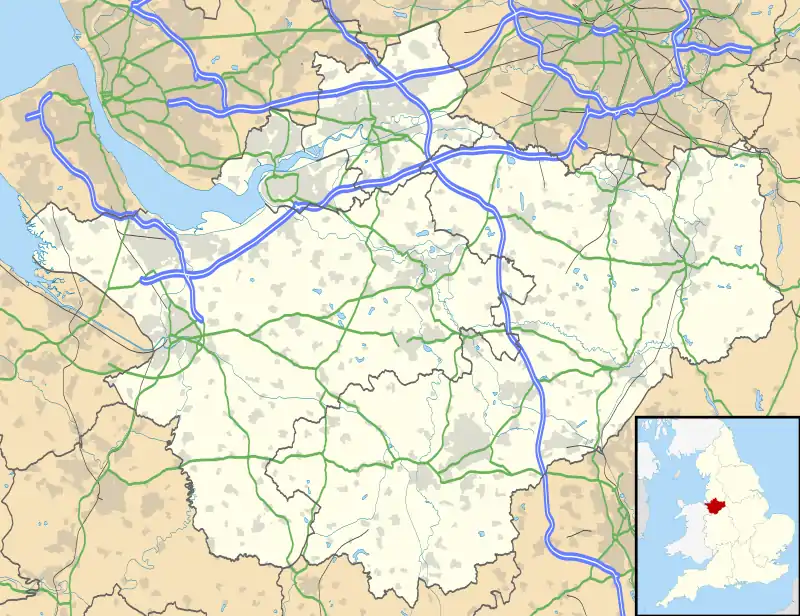Brereton Hall
Brereton Hall is a country house to the north of the village of Brereton Green, adjacent to St Oswald's Church, in the civil parish of Brereton, Cheshire, England. It is recorded in the National Heritage List for England as a designated Grade I listed building.[1]
| Brereton Hall | |
|---|---|
 | |
| Location | Brereton Green, Brereton, Cheshire, England |
| Coordinates | 53.1805°N 2.3288°W |
| Built | 1586 |
| Built for | Sir William Brereton |
| Restored | 1829 |
Listed Building – Grade I | |
| Designated | 6 June 1952 |
| Reference no. | 56338 |
 Location in Cheshire | |
History
The manor of Bretune is listed in Domesday Book. The house dates from 1586, the date inscribed over the entrance.[2] It was built for Sir William Brereton (1550–1631), created Baron Brereton of Leighlin, Co. Carlow in 1624.[3] A portrait of Sir William, dated 1579, with a cameo of Queen Elizabeth in his cap, is at the Detroit Institute of Arts.[4]
William, 3rd Lord Brereton (1631–1679) became an original Fellow of the Royal Society on 22 April 1663.[5] His younger son, Francis, 5th Lord Brereton, died a bachelor in 1722, ending the Brereton family male line.[6]
The house passed to the Bracebridge family,[7] and as Bracebridge Hall re-sited in Yorkshire, it featured in a historical fiction of Washington Irving.[8] In 1817 it was purchased by a Manchester industrialist, John Howard. He made alterations in 1829 to the exterior and interior in Regency style.[7] Further alterations were made in the late 19th century.[1] In the 20th century it was a girls' boarding school. After this closed in July 1992,[9] it was the retreat of a pop star who built a recording studio at the back.[7] Since 2005 it has been a private family home and is not open to the public.[7]
Architecture

The house is one of a genre of splendid Elizabethan and Jacobean houses built for dynastic display called "prodigy houses".[7] It is built in brick with stone dressings, formerly in a E-plan, of which the central wing has been demolished and replaced with a 19th-century conservatory. The front range has a lead roof; the cross-wings are roofed in slate. The front range has a basement and two storeys with a turreted central gateway. The octagonal turrets are linked by a bridge and are embattled (before 1829 they were surmounted by cupolas).[1]
Over the entrance are the royal arms of Elizabeth I in a panel, which are flanked by the Tudor rose and the Beaufort portcullis. Beyond the entrance is a lower hall and a grand staircase leading to a long gallery which runs along the front of the house. This leads to the drawing room which contains a frieze with nearly 50 coats of arms and a chimney piece carved with the Brereton emblem, a muzzled bear. Two fireplaces elsewhere are carved in a Serlian manner. The former study of the 2nd Lord Brereton contains a richly carved alabaster fireplace.[7]
References
- Historic England, "Brereton Hall (1229329)", National Heritage List for England, retrieved 30 March 2012
- A history of the house by A. L. Moir, The Story of Brereton Hall, Cheshire was published in Chester.
- Bernard Burke, A Genealogical History of the Dormant, Abeyant, Forfeited, and Extinct Titles ..., s.v. "Brereton – Baron Brereton".
- Sir William Brereton, 1579, Detroit Institute of Arts, retrieved 17 March 2008
- "William Brereton". Royal Society. Retrieved 5 January 2020.
- Thornber, Craig (2005), "Brereton", Cheshire Antiquities, retrieved 17 March 2008
- Binney, Marcus (12 August 2005). "The Tudor show home". The Times. London. Archived from the original on 16 July 2011. Retrieved 17 March 2008.
Brereton is on the mend. Not, as you might expect, divided into apartments, but as a single grand house waiting for a modern-day Cheshire magnate or football king with price tag to match.
Brereton Hall was for sale at the time, at £6.5 million. - Bracebridge Hall, or The Humorists. A Medley, by "Geoffrey Crayon, Gent." [Washington Irving], rev. ed. 1867. Irving's 'Bracebridge Hall' is itself a medley of seventeenth-century English houses of the gentry.
- Brereton Hall School Website, Zoe Davies, archived from the original on 30 December 2007, retrieved 16 March 2008
Further reading
- Hartwell, Clare; Hyde, Matthew; Hubbard, Edward; Pevsner, Nikolaus (2011) [1971], Cheshire, The Buildings of England, New Haven and London: Yale University Press, pp. 181–183, ISBN 978-0-300-17043-6
- Moir, Arthur Lowndes (1949). The Story of Brereton Hall, Cheshire (2nd ed.). Chester: Phillipson and Golder Ltd.
External links
| Wikimedia Commons has media related to Brereton Hall. |